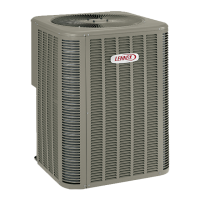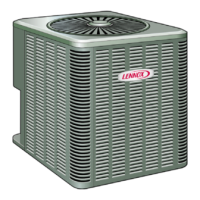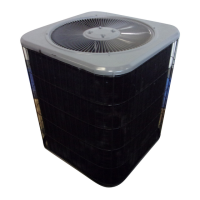Page 40
14HPX OPERATING SEQUENCE
This is the sequence of operation for 14HPX series units.
The sequence is outlined by numbered steps which
correspond to circled numbers on the adjacent diagram.
The steps are identical for both cooling and first stage
heating demand with the exception reversing valve L1 is
energized during cooling demand and de-energized
during heating demand.
NOTE- Transformer in indoor unit supplies power (24
VAC) to the thermostat and outdoor unit controls.
COOLING:
Internal thermostat wiring energizes terminal O by cooling
mode selection, energizing the reversing valve L1.
1 - Demand initiates at Y1 in the thermostat.
2 - 24VAC energizes compressor contactor K1.
3 - K1‐1 N.O. closes, energizing compressor (B1) and
outdoor fan motor (B4).
END OF COOLING DEMAND:
4 - Demand is satisfied. Terminal Y1 is de‐energized.
5 - Compressor contactor K1 is de‐energized.
6 - K1‐1 opens and compressor (B1) and outdoor fan
motor (B4) are de‐energized and stop immediately.
FIRST STAGE HEAT:
Internal thermostat wiring de-energizes terminal O by
heating mode selection, de-energizing the reversing valve
L1.
See steps 1, 2 and 3.
End of FIRST STAGE HEAT:
See steps 4, 5 and 6.
DEFROST MODE:
When a defrost cycle is initiated, the control energizes
the reversing valve solenoid and turns off the
condenser fan. The control will also put 24VAC on the
“W1” (auxiliary heat) line. The unit will stay in this
mode until either the coil sensor temperature is
above the selected termination temperature, the
defrost time of 14 minutes has been completed, or
the room thermostat demand cycle has been
satisfied. (If the temperature select shunt is not
installed, the default termination temperature will be
90°F.) If the room thermostat demand cycle
terminates the cycle, the defrost cycle will be held
until the next room thermostat demand cycle. If the
coil sensor temperature is still below the selected
termination temperature, the control will continue the
defrost cycle until the cycle is terminated in one of the
methods mentioned above. If a defrost is terminated
by time and the coil temperature did not remain
above 35°F (2°C) for 4 minutes the control will go to
the 30-minute Time/Temperature mode.
Servicing Units Void of Charge
If the outdoor unit is void of refrigerant, clean the system
using the procedure described below.
1. Leak check system using procedure outlined on page
22.
2. Evacuate the system using procedure outlined on page
23.
3. Use nitrogen to break the vacuum and install a new filter
drier in the system.
4. Evacuate the system again using procedure outlined on
page 23.
5. Weigh in refrigerant using procedure outlined under
figure 26.
Start-Up
IMPORTANT
Crankcase heater (if applicable) should be energized 24
hours before unit start-up to prevent compressor damage
as a result of slugging.
1. Rotate fan to check for binding.
2. Inspect all factory and field‐installed wiring for loose
connections.
3. After evacuation is complete, open the liquid line and
suction line service valves to release the refrigerant
charge (contained in outdoor unit) into the system.
4. Replace the stem caps and tighten as specified in
Operating Service Valves on page 9.
5. Check voltage supply at the disconnect switch. The
voltage must be within the range listed on the unit's
nameplate. If not, do not start the equipment until you
have consulted with the power company and the
voltage condition has been corrected.
6. Set the thermostat for a cooling demand. Turn on power
to the indoor indoor unit and close the outdoor unit
disconnect switch to start the unit.
7. Recheck voltage while the unit is running. Power must
be within range shown on the nameplate.
8. Check system for sufficient refrigerate by using the
procedures listed under Start-Up and Charging
Procedures.
9. Recheck voltage while the unit is running. Power must
be within range shown on the nameplate.
System Refrigerant
This section outlines procedures for:
1. Connecting gauge set for testing and charging;
2. Checking and adjusting indoor airflow;
3. Adding or removing refrigerant.

